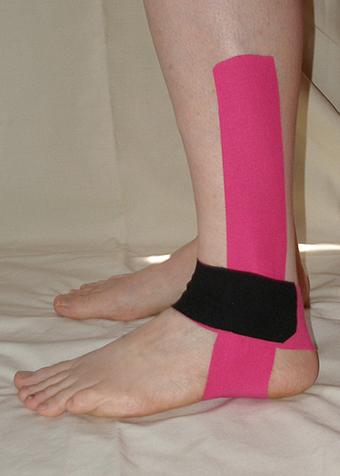
Health & Wellness Committee: Kinesiotape Isn't Just for Olympians Anymore
Views expressed in this article are those of the author, not necessarily the Health & Wellness Committee, and are not a substitute for talking to your doctor.
While watching your favorite sports team, perhaps you have noticed black, beige, pink or blue patches on the skin of some athletes. These are pieces of Kinesiotape, a lightweight cotton and elastic tape that adheres with a wave-patterned acrylic adhesive. This specialized tape has been used successfully to treat orthopedic, neuromuscular, neurological and other medical conditions including strain/sprain, soft-tissue tears, pain, bruising, swelling, scars and more. Its use at the 1988 Olympics in Seoul gave it international recognition. It was introduced to the United States in 1995; however, I first saw it used by the U.S. women’s volleyball team and men’s swim team in the Beijing Olympics in 2008.
Dr. Kenso Kase, a U.S.-trained Japanese chiropractor, developed this tape in 1979. It facilitates the body’s natural healing process while providing support and stability to muscles and joints without restricting their range of motion. It has been proven effective for both the rehabilitative and chronic stages of injury or pain care and can also be used to prevent injuries, and in conjunction with various kinds of treatment.
There is no latex or medication in Kinesiotape. Designed to mimic the perceived weight of living human skin, it is comfortable to wear and can remain in place for three to five days, through bathing, exercise and sleep. Because of this, it is used by sports physicians, physical therapists, chiropractors, massage therapists and other professionals to extend the benefits of their treatment beyond the office visit.
Kinesiotape has the ability to stretch and recoil longitudinally. This recoil action enhances muscular, joint and circulatory activity by adjusting the movement patterns beneath it. It can be cut and applied in many ways. Once applied, it communicates with receptors in our skin that give our brain feedback about the length, strength and position of our muscles, signaling some to reduce tension while stimulating others to take up the slack. By tweaking our movement patterns, the tape helps muscle performance and joint alignment and increases scar mobility. Kinesiotape also microscopically lifts the skin to which it adheres, promoting increased circulation of blood and lymph in compressed, swollen tissue. This decompressive action increases circulation to reduce adhesions, swelling and pain while helping heal bruises incredibly fast. If applied at the time of injury, it can actually prevent bruising from occurring.
Formerly limited to specialists, this remarkable tape is now available to everyone. Many have benefited from its use — pregnant women, weekend warriors, dancers, kids, grandparents, even pets.
You can find Kinesiotape online and in stores as precut pieces and in rolls. The trick is learning when, where and how to use it, as well as when not to. Since it is not a one-size-fits-all product, most people would benefit initially from the guidance of a professional. Look for the CKTP (Certified Kinesio-Taping Practitioner) designation from the Kinesio Taping International Association (KTAI), certifying that professionals have passed a comprehensive exam after completing 24 or more hours of supervised class time learning tape protocols for specific conditions.
You can learn more at kinesiotaping.com, local classes in your area (coming soon) or by checking out videos on YouTube.
Ronda Throne, BCTMB, LMT, CKTP+, added kinesiotaping to her practice to assist people with musculoskeletal and orthopedic conditions and plans plans to offer an “Intro to Kinesiotape” workshop. Contact her at amtamembers.com/ronda.

